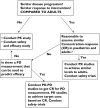Modelling approaches to dose estimation in children
- PMID: 15948929
- PMCID: PMC1884869
- DOI: 10.1111/j.1365-2125.2005.02429.x
Modelling approaches to dose estimation in children
Abstract
Most of the drugs on the market are originally developed for adults and dosage selection is based on an optimal balance between clinical efficacy and safety. The aphorism 'children are not small adults' not only holds true for the selection of suitable drugs and dosages for use in children but also their susceptibility to adverse drug reactions. Since children may not be subject to dose escalation studies similar to those carried out in the adult population, some initial estimation of dose in paediatrics should be obtained via extrapolation approaches. However, following such an exercise, well-conducted PK-PD or PK studies will still be needed to determine the most appropriate doses for neonates, infants, children and adolescents.
Figures





Similar articles
-
Modeling and simulation in pediatric drug therapy: Application of pharmacometrics to define the right dose for children.Clin Pharmacol Ther. 2015 Sep;98(3):298-308. doi: 10.1002/cpt.169. Epub 2015 Jul 20. Clin Pharmacol Ther. 2015. PMID: 26073179 Review.
-
Population approaches in paediatrics.Fundam Clin Pharmacol. 2008 Dec;22(6):575-8. doi: 10.1111/j.1472-8206.2008.00647.x. Fundam Clin Pharmacol. 2008. PMID: 19049657
-
Tailor-made drug treatment for children: creation of an infrastructure for data-sharing and population PK-PD modeling.Drug Discov Today. 2009 Mar;14(5-6):316-20. doi: 10.1016/j.drudis.2008.11.004. Epub 2008 Dec 26. Drug Discov Today. 2009. PMID: 19059496 Review.
-
Delivery of inhaled drugs for infants and small children: a commentary on present and future needs.Clin Ther. 2012 Nov;34(11):S36-45. doi: 10.1016/j.clinthera.2012.10.004. Clin Ther. 2012. PMID: 23149011 Review.
-
A Survey of Neonatal Pharmacokinetic and Pharmacodynamic Studies in Pediatric Drug Development.Clin Pharmacol Ther. 2015 Sep;98(3):328-35. doi: 10.1002/cpt.149. Clin Pharmacol Ther. 2015. PMID: 25975723 Review.
Cited by
-
Estimation of an Appropriate Dose of Trazodone for Pediatric Insomnia and the Potential for a Trazodone-Atomoxetine Interaction.CPT Pharmacometrics Syst Pharmacol. 2020 Feb;9(2):77-86. doi: 10.1002/psp4.12480. Epub 2020 Jan 11. CPT Pharmacometrics Syst Pharmacol. 2020. PMID: 31808613 Free PMC article.
-
Patient-specific dosimetry of 99mTc-HYNIC-Tyr3-Octreotide in children.EJNMMI Phys. 2017 Oct 13;4(1):24. doi: 10.1186/s40658-017-0191-6. EJNMMI Phys. 2017. PMID: 29030760 Free PMC article.
-
Development and evaluation of a generic physiologically based pharmacokinetic model for children.Clin Pharmacokinet. 2006;45(10):1013-34. doi: 10.2165/00003088-200645100-00005. Clin Pharmacokinet. 2006. PMID: 16984214
-
Testing new drugs in naked apes and getting the dose right in their young.Br J Clin Pharmacol. 2010 Oct;70(4):467-70. doi: 10.1111/j.1365-2125.2010.03782.x. Br J Clin Pharmacol. 2010. PMID: 20840438 Free PMC article. No abstract available.
-
Challenges in conducting clinical trials in children: approaches for improving performance.Expert Rev Clin Pharmacol. 2009 Nov 1;2(6):609-617. doi: 10.1586/ecp.09.40. Expert Rev Clin Pharmacol. 2009. PMID: 20228942 Free PMC article.
References
-
- Johnson TN. The development of drug metabolising enzymes and their influence on the susceptibility to adverse drug reactions in children. Toxicology. 2003;192:37–48. - PubMed
-
- Breant V, Charpiat B, Sab JM, Maire P, Jelliffe RW. How many patients and blood levels are necessary for population pharmacokinetic analysis? Eur J Clin Pharmacol. 1996;51:283–8. - PubMed
-
- Lee PID. Design and power of a population pharmacokinetic study. Pharm Res. 2001;18:75–82. - PubMed
-
- Johnson TN, Rostami-Hodjegan A, Goddard JM, Tanner MS, Tucker GT. Contribution of midazolam and its 1-hydroxy metabolite to pre-operative sedation in children: a pharmacokinetic-pharmacodynamic analysis. Br J Anaesth. 2002;89:428–37. - PubMed
Publication types
MeSH terms
Substances
LinkOut - more resources
Full Text Sources
Other Literature Sources
Medical

